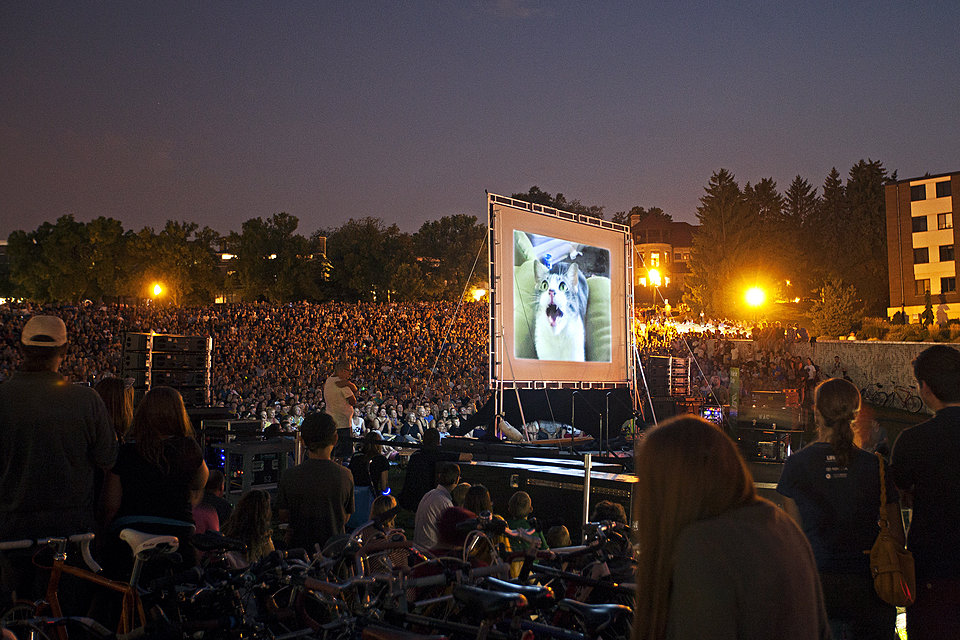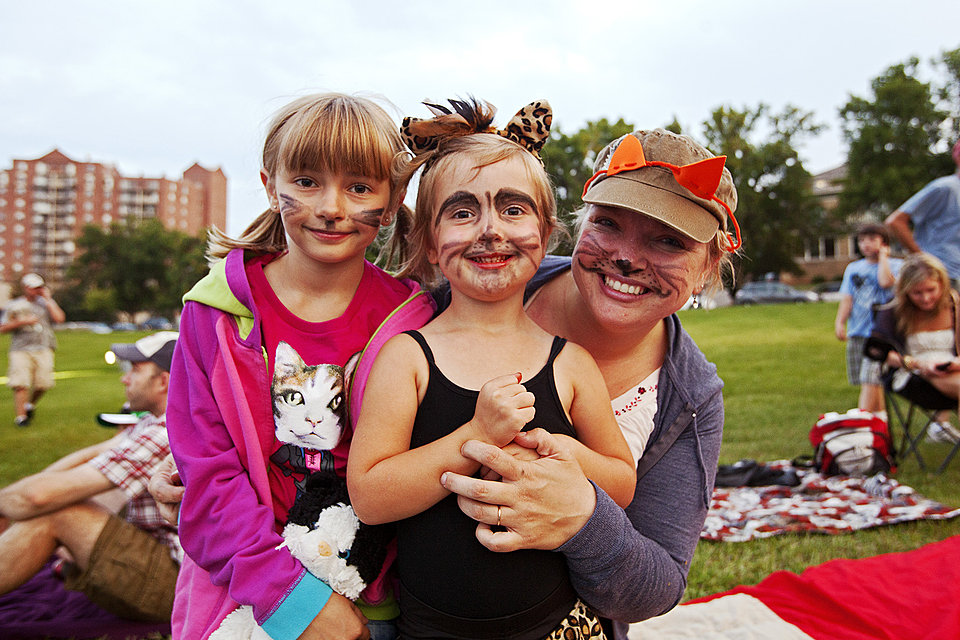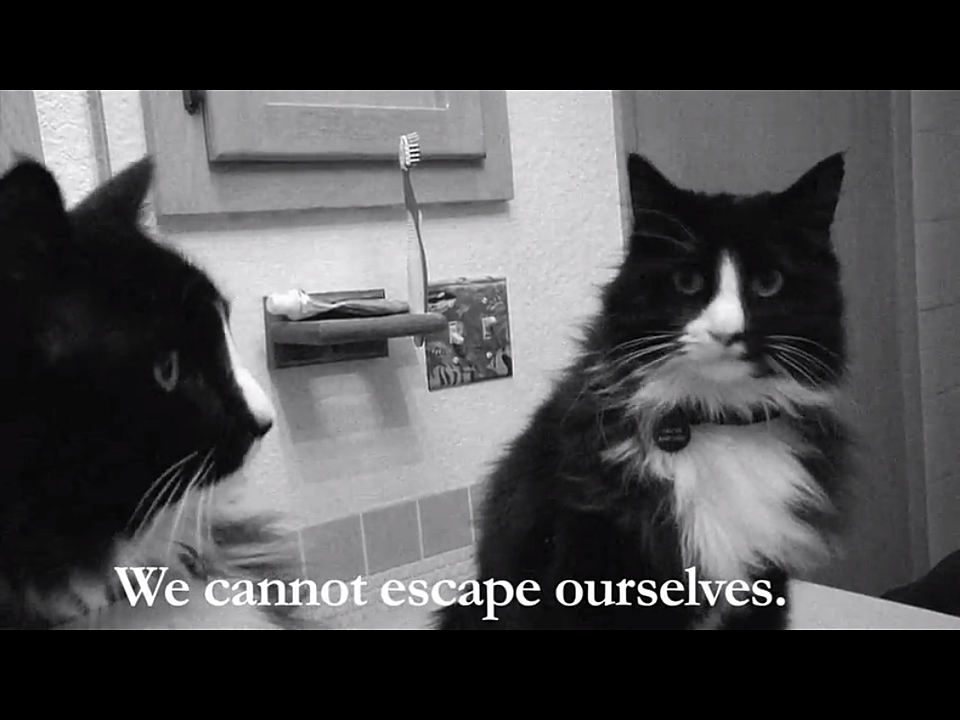

The world's first Internet Cat Video Festival was an unparalleled and unexpected success. A viral sensation online, sparking news headlines worldwide, the festival itself saw the convergence of 10,000 people -- some in costumes, others cradling kitty companions, all feline fanatics -- on the Walker Art Center's hillside one warm August evening last year. Since then the festival has spawned other lives: a national (and possibly international) tour, continued interest from the media, and a bigger, better version planned in Minneapolis/St. Paul in August 2013.
Part of Open Field, the Walker's summertime experiment in community and the commons, the festival moves in 2012 from the grassy lawn beside the art center to the Minnesota State Fair due to construction on the Walker grounds this summer. But for a crowd-sourced, communal experience, the "Great Minnesota Get-Together" makes for an apt setting, says Scott Stulen, mnartists.org project director and festival producer. In a wide-ranging conversation, he discusses cat culture, viral trends online and how the Internet is the cat lover's version of the dog park.
Paul Schmelzer: Since announcing the first-ever Internet Cat Video Festival in May 2012, you've had around 400 media requests related to it, plus stories and news segments that have appeared around the world -- from Brazil to Thailand, Japan to all corners of the US. What is it that made the story catch on?
Scott Stulen: I think, initially, it's just a cute story. It was something unique. Also, we were very aware that we were tapping into a powerful meme, and we knew there was some interest with it. But it was a big experiment to see if that would translate offline into a different setting. It's one thing when people enjoy cat videos individually on their computers; it's another when it's a big screening out on our lawn. Then, of course, the alignment with the Walker added fuel to the fire. If we did this in my backyard, we probably would've had 10 people show up, not 10,000.
Schmelzer: Early on, many of the news stories seemed to key in on the same storyline -- contemporary art center sanctifies cat videos as high art -- which was never the Walker's intent. Why do you think they did that?
Stulen: Well, that's a better story! There was definitely connecting of the dots by some media, and that wasn't intended by us. But considering it now, almost a year later, I think the festival also gave people permission to say, "Oh, I love this, and now it's certified that it's okay," and that this isn't totally frivolous, that there's something kind of serious to it. While some people want to dismiss the whole thing, there is more meat to it. I also think that it's not really a serious critique of this form either. It's somewhere in between.
Schmelzer: Of all the news outlets that picked up the story, are there any reports that stood out?

Stulen: The one that I keep going back to, because it's one of the more interesting stories, was one by the writer for Jezebel, Madeleine Davies. She wrote and told us that she was assigned to come here with her editor and shred this thing and make fun of everybody at this event. She actually wrote that in her article: "I would go in and ask outrageous questions that would quietly to not-so quietly mock these cat lovers to their faces. ... I would, in short, be a total asshole, all for the sake of comedy." But then she ended up writing one of the more touching pieces that really talked more about Open Field and this whole experience. She really got it.
Schmelzer: "Got it" in what sense? What was the takeaway?
Stulen: She turned it back on herself. One of the key quotes for me: "What is sad, I've realized, is that we've gotten to the point in which people gathering together and celebrating something positive is considered lame." She essentially said there's something wrong with society when our first reaction is often to ridicule those who are earnestly having fun, or when there always needs to be layers of irony in it, like there's skepticism in purely sincere, joyous acts. She closed by writing about how after the event, she noticed people in the parking ramp who started out the evening as strangers and were now talking like new friends. To some extent, that's what we have been trying to do with Open Field all along -- to have those moments happen. This was Open Field on steroids.
This social aspect is key: the festival isn't just about watching cat videos, because you can do that at home. It was about what's it like to watch cat videos with others.
Schmelzer: Right. Watching cat videos online is a pretty solitary experience.
Stulen: Sitting outside and watching people all laugh -- 10,000 people -- at one of these videos is actually somewhat absurd, but it also creates a whole different environment for that activity. To some extent, that's what a lot of Open Field is about too: let's set up this platform for something to happen, we're not quite sure what and then we'll just see what unfolds. If it weren't for a program like Open Field, it would be very hard for this kind of event to happen within the Walker. It needed that shelter to be able to happen and not get crushed to some extent.
Schmelzer: Do you mean the distance from the Walker's Film/Video curators, for instance, allowed it to happen?
Stulen: Yeah. For both of our sakes.
For the program's sake to be on its own and not have to go through the normal channels and be its own entity, and also for their sake. The Walker's film department is internationally known for curating daring and experimental, global work. As they weren't involved in the cat video festival, they need a shelter from it too.
Schmelzer: Were you surprised by the success of the idea online and, more importantly, the turnout at the screening last August?
Stulen: Absolutely. I don't think anybody thought 10,000 people were going to show up, including me, and I was probably the most optimistic out of everybody. I had my fingers crossed for maybe 5,000.
Schmelzer: Even when you first hatched the idea?
Stulen: I thought it would be Katie Hill [co-organizer of the event] and I on a laptop and 50 people outside watching a projection on the white wall -- basically Walker staff and friends sitting around with a case of beer and that would be the end of it. [Laughs]
After the press release went out and went viral, we started having an inkling the festival might have a bigger life. Actually, the night before the event, I had this gut feeling that this might be bigger than we were thinking. That morning I called everybody and said, "I know it's last minute, I don't care what it costs, get the biggest screen we can get, the biggest sound system we can get." So we upped everything that morning -- more bike racks, porta-potties, etc.
Schmelzer: Beyond the huge crowd that showed up, it's had another life -- on the road.
Stulen: Right. It's on tour. We did a couple of little experiments in the fall. I took it to UMass Boston in October 2012. We did a small one there, kind of under the radar, to see how it traveled. And then we took it to the Museum of Photographic Arts in San Diego for presentation in a theater, to see how it worked in that kind of setting. They sold out two shows in San Diego. The content works and I think people really get it for what it is.

But what's been really interesting is who's been contacting us about restaging the festival. It's been nonprofits and other museums, not commercial entities. I've had over 50 requests to restage it elsewhere. We took it to Memphis for an event at the Brooks Museum, which is a lot like the Walker's Target Free Thursday Nights. Then I did one at a small theater in Auburn, New York, that was for a nonprofit for animals and the Humane Society. Then we headed to SXSW to do it as part of a presentation called "#cadvidfest: Is This the End of Art?"
Schmelzer: When we launched the redesigned Walker website in December of 2011, we sort of jokingly and with a nudge, nudge, wink, wink, started doing a weekly Cat Break in our Art News from Elsewhere section as a way of acknowledging this well-known fact that cats burn up the Internet and making the cat meme our own by giving it a quirky, contemporary art and design feel. But it seems like a lot of times cats are used on the Internet as a ploy to spike traffic: it's the cotton candy of web content, not a lot of substance to it, really light and fluffy. But with the venues that are on tour, that doesn't seem to be the case. They're not just looking for a cheap crowd-pleaser.
Stulen: They're not. And the interesting thing, too, is they're seeing it in essentially the same light we are. They're seeing it in both ways. Yes, there are some things about this that are pure entertainment. It is cats jumping off tables and things, but there's a more critical view as well. What does this type of content, that is so popular out in the world, mean for society? What's it mean for the relevance of a museum, and if you're reflecting what's happening in contemporary society, what does this mean for how content is produced and distributed?
So when everybody who has a blog or a Pinterest board is calling themselves a curator, and everybody has a cell phone that can produce high-definition videos and send them out and have millions of people see them, it changes the possibilities for artists and museums. I think that's an interesting conversation. I am not to the point I am going to call these high art. But I think it's interesting how these things cycle and are distributed. With the videos we selected for the festival, there is a full range -- from Cory Arcangel, who is an established artist, to Will Braden, a trained filmmaker who won our Golden Kitty award, to people who used a cell phone to shoot a cat jumping off the table. In the realm of the cat videos, those are both side by side. There is a certain flatness of it, which is kind of strange too, right?
Schmelzer: Right. It's like Art House Cinema meets Americas Funniest Home Videos... So, tell me about what goes into "curating" cat videos.
Stulen: As I worked as a curator myself [at Minnesota's Rochester Art Center] and I do this type of work, I've given it a lot of thought and, honestly, you look at it the same you would any other artwork. Is it compelling? Is it interesting? Has anybody seen this before? How does the production meet the intent? All the same things you look at any work of art.
Schmelzer: The next life of the festival is the 2013 edition, which will take place not on the Walker's Open Field but at the Minnesota State Fair. It's sure to have a distinctly different feel due to the setting, but it also has the potential of attracting even more people. Any concerns about the change of venue?
Stulen: Yes and no. There are pluses and minuses to it. The nice thing about having it here at the Walker is having it adjacent to the museum, on the grass and having it completely open and free. At the fair it will be at the grandstand, so there will be a very low ticket price but it will be ticketed.

Schmelzer: And the reason why we're doing it there is because of the construction happening at the Walker this summer?
Stulen: Yeah. The site isn't available. If it was, we'd do it here, for sure. But I think the spirit of the Minnesota State Fair is very much in the same spirit as Open Field and this particular event. Having a big crowdsourced festival at the fair makes a lot of sense, too. It'll have the same kind of atmosphere -- bands, other nonprofits, artists' projects, access to food and drink, the same things we would have done if it was here. The Golden Kitty Award-winner Will Braden is going to come back as a special guest. He'll debut a new Henri video that night and be here to hand out the award for the new People's Choice Award. And then we're also going to add a few categories, including one specific to Minnesota -- a Cat-on-a-Stick -- that we're going to do.
Schmelzer: For last year's festival, there were many cats in the audience. I'm guessing that can't happen at the fairgrounds?
Stulen: Unfortunately, the cats aren't welcome. That's the one drawback of it. But we may have some celebrity cats here for the event. Right after this event, the tour continues. I already have two events booked in the fall with four more pending, including a film festival in Austria that may want to screen it -- like a legit film festival in Austria.
Schmelzer: So that'll be the real story: "Legit Film Festival Sanctifies Cat Videos as Art."
My last two questions: "Why do cat videos continue to be so popular?" and "Why cats instead of dogs?" This dog person wants to know. [Laughs]
Stulen: I don't know how many interviews I have done with that question. There are different ways to answer that. I think one is that dogs feel like they are performing for you and cats couldn't care less. Then there's the difference between the two kinds of pet owners. One person at the festival commented, "Dog owners want their dogs to be human, cat owners want to be cats."
Schmelzer: Ha!
Stulen: And I can say that from some of the people who showed up here, this seemed to be true. [Laughter] That said, I also think there's a universal quality to this. We got submissions from all over the world -- including from Japan and Russia -- so the nature of the content is understandable regardless of the language and the cultural differences. And for our event last summer, the crowd included everyone from Uptown hipsters to retirees who live across the street to families from suburbia.
Schmelzer: Cats are the great equalizer ...
Stulen: The one other thing I've thought about, too, is that difference between cat and dog owners and the social aspect of that. So most cat owners' cats stay in their home, they don't go out and socialize with other cats the way, perhaps, dog owners do.
Schmelzer: There's no cat park?
Stulen: There's no cat park. The cat park is the Internet.
